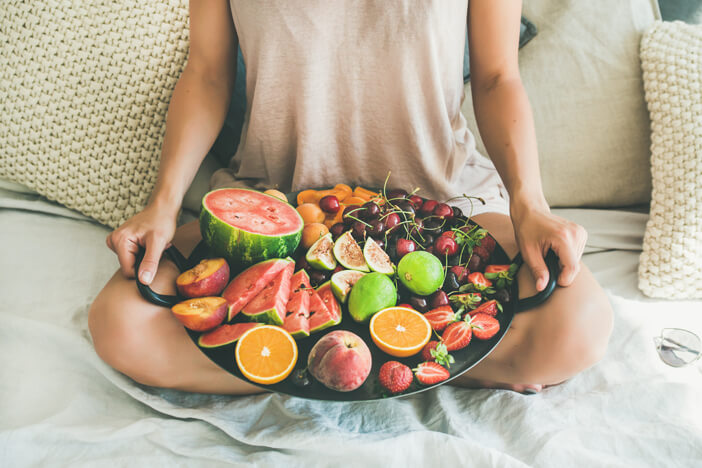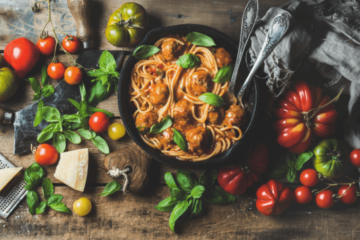Healthy eating - The comprehensive guide to clean eating

Who is this guide for?
Do you want to achieve and maintain weight loss, feel fit and healthy, and be full of energythroughout the day? Do you sometimes ask yourself: “What is a healthy diet exactly?”? Then this guide is the right one for you.
Healthy eating and clean eating
The average diet in many countries is characterized by an enormous number of foods whose quality and nutritional value are shaky at best. Additives, artificial flavors, preservatives, sugars, or sweeteners often go unnoticed, so that it is not clear to many people just how unhealthy much of the foods available are. So how do you eat well?
Healthy eating
There are many causes of poor nutrition. In some cases, people just don’t have the time to think about nutrients, additives, or recipes. It can be tempting to grab processed, pre-packaged meals and snacks. After all, these are often very flavorful, quick, and inexpensive. But healthy eating can be just as easy. In this guide, we’ll show you that healthy foods don’t have to be expensive and how you can easily become a healthy eating expert. And our free healthy eating plan can help you get a feel for what healthy eating habits in everyday life look like.
Where less is more
Unfortunately, wheat is not only food contaminated with pesticides, but also contains an increased percentage of gluten. White flour, in particular, has no place in a healthy diet: it loses all its healthy fiber and micronutrients through processing. Another group of foods that should be considered with healthy skepticism is dairy products. Although most people in Central Europe and America tolerate dairy products in moderation, these products create an acidic environment in the body that tends to cause inflammation. An absolute “No Go” for a healthy diet are any industrially processed foods. Many of the packaged items on supermarket shelves are treated with additives to improve the taste, shelf life or appearance of a product. These additives harm your metabolism, conceal the poor quality of the basic ingredients, change your taste perception, and, in the worst case, lead to addictive behavior.
Variation is the key
In addition to the 3 taboo food groups already mentioned, there are many foods, that in and of themselves are not unhealthy, but when eaten in large amounts are detrimental to your health. One of the keys to a healthy diet is therefore not to eat only 3 or 4 different foods, but rather to eat a wide variety of foods, and it is important to use fresh, unprocessed food as much as possible—a diet that is increasingly known under the keyword “clean eating”. In this way, you can avoid developing food intolerances—which often have their origin in an unbalanced diet—and supply your organ’s energy system sufficiently with nutrients.
The amount of food you eat also plays a big role when it comes to eating a healthy diet because both too much and too little food harms your health. Being both overweight and underweight are associated with numerous diseases. You can calculate your daily caloric need (how many calories per day is healthy for you) by determining your basal metabolic rate and multiplying it by your activity factor. The Benedict Harris formula is the most accurate and most commonly used. Alternatively, you can simply use our practical BMI and Calorie Calculator to determine all of this for you.
Formula for basal metabolic rate
Basal metabolic rate for men (calories per day): 66.47 + (13.7 x body weight in kg) + (5 x body size in cm) – (6.8 x age in years)
Basal metabolic rate for women (calories per day): 655.1 + (9.6 x body weight in kg) + (1.8 x body size in cm) – (4.7 x age in years)
This basal metabolic rate is your daily minimum calorie requirement. It doesn’t include the calories burned from physical activity e.g. exercise or work. To calculate your daily needs, you:
Multiply your basal metabolism by:
- 1.4 – for a mainly sedentary lifestyle and little to no activity (e.g. office work, couch potato)
- 1.6 – for moderately strenuous, alternately sedentary, standing and walking activity (e.g. studying, assembly line work) or mostly sedentary lifestyle combined with occasional exercise/workouts
- 1.8 – for an active lifestyle with a moderately high level of physicality (e.g. waiters, craftsmen) or sedentary lifestyle combined with frequent exercise/workouts
- 2.0 – for a physically demanding lifestyle (e.g. furniture packer, construction worker, fitness trainer) or moderately active lifestyle combined with frequent exercise/workouts
- 2.2 – for a very active lifestyle and frequent exercise/workouts (e.g. professional athletes)
It is not important to eat exactly your calculated calorie requirement every day, but on average, you should not deviate too much from it (+/- 200 kcal per day).
The macronutrient distribution in a healthy diet should be roughly as follows:
- About 50% carbohydrates
- 25 – 30% fat
- 20 – 25% protein
No desire to recalculate all this again and again? No problem: Our BMI or calorie calculator tells you how many calories and nutrients you need every day to be and stay healthy.
Proteins

Healthy protein sources
A healthy diet includes about 1-2g of protein per day per kilogram of body weight. Low-fat meats and fish products are usually best: they contain fewer calories than high-fat meats, are easier to digest, and have little or no effect on the acid-base ratio in your body. Processed meats such as sausages are unsuitable in a healthy diet due to the additional fats and additives.
Meat
| Product | Protein / 100 g | Fat / 100 g | Suitability* |
|---|---|---|---|
| Ham | 33 g | 2 g | high |
| Venison | 24 g | 3 g | very high |
| Turkey schnitzel | 24 g | 2 g | very high |
| Chicken breast fillet | 23 g | 2 g | very high |
| Eye of round Ham | 23 g | 3 g | high |
| Irish flank steak | 22 g | 2 g | very high |
| Pork fillet | 22 g | 2 g | high |
Fish & Seafood
| Product | Protein / 100 g | Fat / 100 g | Suitability* |
|---|---|---|---|
| Tuna fillet without oil | 24 g | 1 g | high |
| Pikepurch | 20 g | 1 g | very high |
| Guilt-head bream | 19 g | 2 g | very high |
| Cod fillet | 16 g | 1 g | very high |
| Shrimp | 15 g | 1 g | high |
| Scampi | 15 g | 1 g | high |
Other animal products
| Product | Protein / 100 g | Fat / 100 g | Suitability * |
|---|---|---|---|
| Feta light | 19 g | 9 g | medium |
| Cottage cheese | 12 g | 4 g | medium |
| Low-fat yogurt | 12 g | < 1 g | high |
| Skyr | 12 g | < 1 g | high |
| Kaviar | 11 g | 4 g | medium |
Plant-based products
| Product | Protein / 100 g | Fat / 100 g | Suitability* |
|---|---|---|---|
| Tempeh (tofu alternative) | 17 g | 9 g | high |
| Tofu | 13 g | 10 g | medium |
| Lentils cooked | 8 g | 1 g | medium |
| Chickpeas cooked | 5 g | 1 g | low |
| Quinoa cooked | 4 g | 2 g | low |
| Mushrooms | 3 g | < 1 g | high |
| Broccoli cooked | 3 g | < 1 g | high |
| Cauliflower cooked | 3 g | < 1 g | high |
* The suitability of a protein source depends on the biological value of the protein it contains, as well as the proportion of protein to the total calories of the food and other health-related properties.
Fats

Healthy fats
Oils and nuts contain good fats, which you need to have enough building material for cell membranes, signaling substances, vitamin transporters; and to regulate your blood cholesterol and to make the fat metabolism as efficient as possible. Fats consist of fatty acids, which are found in short, medium, and long molecular chains and in 3 different forms: saturated fatty acids, monounsaturated, and polyunsaturated fatty acids. All three types have different functions in the body: some are broken down are and used as energy sources (saturated fatty acids), some regulate cholesterol (monounsaturated fatty acids) and others are the building materials and transporters (polyunsaturated fatty acids). Only use fats that come from fresh sources or healthy oils and avoid processed foods with high-fat content. You should eat about 1 g of fat per kg of body weight per day, of which one part (min. 5 g) is monounsaturated and polyunsaturated fatty acids — your body cannot make them on its own so they must be added to your diet.
Saturated Fats
| Product | Saturated fatty acids / 100 g | Value |
|---|---|---|
| Coconut fat | 85 g | very high |
| Palm kernel fat (not palm oil) | 78 g | high |
| Cocoa butter | 59 g | high |
| Pumpkin seed oil | 52 g | high |
| Butter | 50 g | high |
| Cream cheese | 22 g | medium |
Monounsaturated fatty acids
| Product | Monounsaturated fatty acids / 100 g | Value |
|---|---|---|
| Olive oil | 71 g | very high |
| Macadamia nuts | 57 g | very high |
| Hazelnuts | 52 g | high |
| Pecans | 45 g | very high |
| Sesame oil | 41 g | very high |
| Almonds | 34 g | very high |
| Avocado | 8 g | high |
Polyunsaturated fatty acids
| Product | Polyunsaturated fatty acids / 100 g | Value |
|---|---|---|
| Safflower oil | 74 g | high |
| Walnut oil | 68 g | high |
| Linseed oil | 67 g | high |
| Pumpkin seed oil | 52 g | high |
| Sunflower oil | 51 g | high |
| Sesame oil | 43 g | high |
Carbohydrates

Carbohydrates make up a large part of a normal healthy diet. But carbohydrates are not all created equal. While short-chain carbohydrates such as sucrose (household sugar) and fructose affect your blood glucose levels to spike quickly and heavily, complex carbohydrates (e.g. vegetable starches) raise your blood glucose levels slowly and evenly. The glucose in complex carbohydrates provides you a long-term supply of energy. Other digestive nutrients such as fats, fiber, and micronutrients also help to slow the absorption process. This is another reason why fruits are better for your blood sugar than bakery products—although they have comparable sugar content. Fruits also provide additional nutrients that need to be digested, while baked goods contain virtually no valuable nutrients.
You should get most of your carbohydrates from a wide variety of vegetables and some complex carbohydrates (see below). An easy way to determine a suitable vegetable portion is with your hands: every day you eat about 5-6 handfuls of vegetables and 1-2 handfuls of fruit. Alternatively, you can use your plate: about 2/3 of the food on your plate should be veggies. Vegetables contain few calories (low energy density), so you can eat vegetables in large quantities without risking a calorie surplus; and various types of vegetables provide you with a wide range of vitamins, minerals, and phytochemicals that are important for your metabolism. Also, vegetables are rich in fiber—which makes them filling and excellent for digestion.
You should try to eat vegetables from each of the 5 vegetable groups every day:
- Green leafy vegetables
- Mushrooms
- Brassicas
- Root and tuber vegetables
- Pulses (e.g. beans, lentils)
Cooked vegetables
| Product | Kcal / 100 g | Suitability* |
|---|---|---|
| Red lentils | 97 kcal | high |
| Arugula raw/td> | 26 kcal | very high |
| Broccoli | 23 kcal | very high |
| Carrots | 21 kcal | high |
| Kohlrabi | 20 kcal | high |
| Bell peppers | 20 kcal | high |
| Zucchini | 19 kcal | very high |
| Eggplant | 17 kcal | high |
| Mushrooms | 15 kcal | high |
Tip: If you don’t use fresh vegetables within 2 days, you should freeze them to preserve the vitamins and nutrients they contain (these decrease considerably at room temperature). While you should definitely avoid the “fast” carbohydrates contained in sugary products, you can easily consume a moderate amount (about 2 g per kg body weight per day) of complex carbohydrates. Complex carbohydrates affect your blood sugar significantly less and keep your energy levels stable. Unprocessed complex carbohydrates also contain a lot of fiber.
Complex carbohydrates
| Product | Carbohydrates / 100 g | Value |
|---|---|---|
| Raw oatmeal | 59 g | medium |
| Basmati rice cooked | 27 g | medium |
| Bulgur cooked | 25 g | medium |
| Quinoa cooked | 19 g | high |
| Lentils cooked | 17 g | high |
| Apple | 14 g | high |
| Potatoe cooked | 14 g | medium |
| Sweet potatoe baked | 14 g | medium |
| Blueberries | 8 g | high |
| Paleo bread | 5-15 g | high |
Superfoods

Foods that are particularly rich in healthy nutrients are known as superfoods. Superfoods are a good addition to a healthy diet, but they are not essential. You should be able to get most of the necessary nutrients from a balanced, varied diet. Superfoods are also popular because they are exotic and thus add variety to the menu. For most superfoods, however, there is a local alternative that may not sound as exciting but is more readily available and also cheaper. Some of these alternatives can even be harvested in your nearest forest or park. Some of the superfoods, such as moringa, ginger, goji berries or turmeric, can also be grown on a balcony garden without much effort.
Superfoods and alternatives
| Product | Property | (Regional) Alternative |
|---|---|---|
| Acai berries | Vitamins, antioxidants | Blueberries |
| Chia seeds | Vegan Protein, fiber, antioxidants | Linseeds, nettle seeds |
| Goji berries | Vitamin C, minerals, protein | Nettle, fenugreek, broccoli, cabbage |
| Pomegranate | Antioxidants, minerals | Broccoli, arugula, mushrooms |
| Ginger | Vitamin C, minerals, anti-inflammatory | Chili, (cayenne pepper) |
| Tumeric | Anti-inflammatory, helps with digestion | Chili, (cayenne pepper) |
| Matcha | Lowers cholesterol, lowers blood pressure, stimulating, antioxidants | Dandelion, chamomile, garlic |
| Moringa | Vitamins, minerals, fatty acids, a folic acid | Combination of kale, nuts, and seeds |
| Quinoa | Protein, minerals | Millet |
Beverages
1. Water
Drink a lot of water—you should drink about 3 liters every day. Your water and electrolyte balance is crucial for your performance and health.
2. Coffee
You can easily include up to 3 cups of coffee (preferably without milk and sugar) as a portion of your water consumption every day. Due to the lower amount of caffeine as compared to filter coffee, we recommend an “Americano”, i.e. a watered-down espresso. Contrary to popular belief, a shot of espresso contains less caffeine than a cup of brewed coffee. If you extend the espresso with hot water so that you have a normal cup full, the taste is still strong, but the amount of caffeine is lower than with a filtered cup of coffee. Do not drink 3 coffees in a row, but spread them over the day between breakfast and 4 pm. Caffeine stays in our body for about 6 hours, and our bodies can only it tolerates a moderate amount of it. This means that a sudden spike in your body’s caffeine level is followed by a strong feeling of exhaustion as soon as your caffeine level drops again. And since there is a habituation effect with caffeine, you tend to need more and more coffee to feel an effect. So it is better to keep the amount of caffeine per coffee low and spread your coffee throughout the day to prevent getting used to its effects.
3. Tea
Unsweetened tea, like coffee, counts towards your water intake. Green tea has stimulating and antioxidant properties (it protects your cells against free radicals) and is, therefore, a good substitute for coffee. But be careful not to choose sweet teas with added flavors. Tea, like coffee, has a dehydrating effect in large quantities,—we recommend no more than 1-3 cups per day.
4. Infused water
Infused waters can help inspire you to increase your water intake. No need to limit this to lemon-infused water either: try pineapple and jalapeno, or wild herbs like ivy and nettle, or refreshing mint and lime—many other combinations can make water exciting and varied. The rule for infused water is: do it yourself! Ready-to-drink infused waters generally contain artificial flavors and sweeteners that you should avoid. It is sufficient to put just a few slices of citrus fruit in your water—and possibly add a little mint or ginger. The taste permeates within minutes and with it a few vitamins and minerals as well.
5. Juice spritzer
There are some important guidelines for drinking juice spritzers: You should mix them yourself, in a ratio of 4:1 water to juice; juice spritzers should be drunk in moderation as they are higher in calories, and just like coffee and tea, juice spritzers should only be drunk 1 glass per sitting. In total, you should not drink more than 3 glasses of fruit juice spritzer per day—At 250 ml per glass. This makes up about 1/4 of your minimum daily water intake.
No Go's
These and related foods are absolutely unsuitable to include in your diet if you want to eat healthily. Avoid them—with no exceptions. In addition to being high in calories and containing many fattening agents (e.g. additives, fast carbohydrates), many of these foods affect your brain in a way that ensures that you develop a desire to keep eating them regardless of how full you are. Alcohol is also a no-go: it reduces your activity level and slows down your metabolism and detoxification processes in your body. If you must drink alcoholic beverages, drink in small quantities (2 glasses max.) and choose dry wines.
Examples of no-go's
| Category | Examples |
|---|---|
| Alcohol | Beer, spirits, longdrinks, cocktails, alcopops |
| Other processed foods | Ready-made sauces, salad dressings, preserves, ready-to-eat meals, frozen pizza, soup mixes |
| Cereals | Cornflakes, smacks, cocoa crispies, pre-packaged granolas |
| Ready-made dairy products with additives | Fruit yogurt, milk rice, pudding, tiramisu |
| Deep-fried foods | Vhips, fries, churros, shortbreads |
| Processed meat products | Franks, salami, meat sausages, Bologna |
| Candies | Gummies, licorice, bonbons, chewing gum |
Healthy eating—conclusion
The benefits of healthy eating are many. If you focus on eating mostly fresh, healthy foods, you will soon feel an enormous increase in your well-being. Your skin will improve, you will sleep better, and feel more energetic. With the right recipes or nutritional plan, you will see that healthy eating is child’s play. Above all, your body and mind will thank you!



